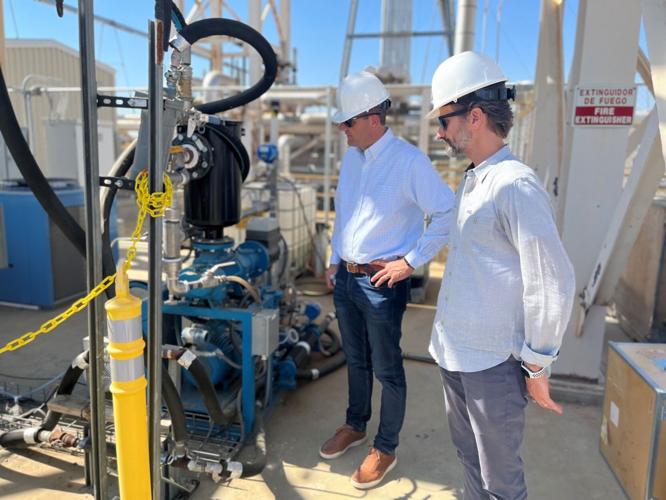Pilot Project Near Shafter Removes Carbon, Produces Water
Published by Todd Bush on August 12, 2024
A demonstration project near Shafter is testing technology for removing carbon dioxide directly from the atmosphere without the need for water — a big advantage in Kern, which has plenty of the resources required except that one.
Avnos Inc. calls this approach hybrid direct air capture (HDAC). This year, the Los Angeles-New Jersey startup raised $36 million on the promise that its patented approach can be scaled up around the world at a lower cost, with fewer barriers, and possibly more local buy-in than other technology on the market.

Rep. David Valadao tours a carbon removal pilot facility in the Bakersfield area. Though skeptics continue to object to such projects for safety and other reasons, the new industry of carbon management views Kern as ideal for its geology, infrastructure and industrial know-how.
>> In Other News: ArtIn Energy Secures Monumental $25.4 Billion Green Hydrogen Contract To Reduce 25.5 Million Tons in CO2 Emissions
Avnos, founded in May 2020, licenses out its technology instead of building its own large projects. As such, it is a partner in four direct air carbon removal projects — two proposed in Kern — that the U.S. Department of Energy has selected for multimillion-dollar grants for addressing climate change.
The company says it is also working with the U.S. Office of Naval Research at a scale 15 times larger than the facility north of Bakersfield.
Avnos' machine dehumidifies air before using chemicals to soak up CO2. Heat produced in the process is then redirected for use in releasing the gas and water.
The model being tested north of Bakersfield, called Project Alpine, collects but does not currently store CO2. With a capacity of 30 metric tons of CO2 per year, it produces five times that amount of distilled water, or about 39,626 gallons per year.
Avnos says other direct air capture technologies work the opposite way, consuming 4 to 10 tons of water to remove a single ton of carbon while also requiring more energy. This distinction makes Avnos' technology "highly deployable," it says, requiring relatively little supporting infrastructure and providing a tangible benefit for neighbors.
"Avnos has, by design, addressed potential barriers to scaling because of the urgency we feel to cool the planet and capture the global, economic opportunity," the company said by email.
In Kern, large-scale carbon removal projects enabled by government and private investment have stoked hopes of local economic development gains. Though skeptics continue to object for safety and other reasons, the new industry of carbon management views Kern as ideal for its geology, infrastructure, and industrial know-how.
Future projects Avnos plans in Kern are expected to provide engineering, construction, and maintenance jobs, many of them expected to leverage transferable skills from legacy energy employment, the company said. It noted it is involved in workforce "upskilling" efforts with the Kern Community College District, its California Renewable Energy Laboratory, and Kern Economic Development Corp.
On July 31, Rep. David Valadao, R-Hanford, toured the HDAC. He said later in a news release, "It was great to learn more about how this kind of carbon removal technology can be used to remove legacy emissions and protect energy jobs in our community."
Subscribe to the newsletter
Daily decarbonization data and news delivered to your inbox
Follow the money flow of climate, technology, and energy investments to uncover new opportunities and jobs.
Companies
Latest issues
-
64 Carbon Projects Were Stuck. Texas Just Unlocked Them
Inside This Issue 🛢️ 64 Carbon Projects Were Stuck. Texas Just Unlocked Them ⚙️ In Ohio, Hydrogen Industry Presses on Despite Federal Uncertainty 🧲 Agami Zero Breaks Through With Magnetic Hydrogen...
-
This U.S. Plant Might Change Aviation Forever
In This Issue 🛫 A Georgia Plant Just Cracked Aviation's Fuel Puzzle 📉 CO2RE And ERM Release 2025 Update On Greenhouse Gas Removal Costs 🔗 Abatable Partners With BlueLayer To Streamline Corporate C...
-
Canada Just Made CCUS Way More Profitable
Inside This Issue 💼 Canada Unlocks EOR for Federal Tax Credits in Landmark Policy Shift 🚀 Carbontech Funding Opens as CDR Sector Pushes for Net-Zero Standard Revisions 💧 CHARBONE Confirms its Firs...
Company Announcements
-
Step strengthens Louisiana’s role in U.S. energy leadership and advances project finance process for biomass‑to‑fuel facility SACRAMENTO, Calif. & NEW ORLEANS -- DevvStream Corp. (Nasdaq: DEVS...
-
Climeworks Opens the World’s Largest Direct Air Capture Innovation Hub
Key takeaways: Climeworks launches the largest innovation center for Direct Air Capture, employing over 50 engineers in Zurich, Switzerland. The center is designed to reduce the cost and increase...
-
XCF Global Moves to Double SAF Production with New Rise Reno Expansion
Initial development completed at New Rise Reno 2, advancing XCF's second SAF production facility and positioning construction to begin in 2026. $300 million planned investment will double XCF'...
-
Carbon Capture Technology Relies on High-Performance CO2 Sensors
As the Global South's first Direct Air Capture (DAC) company, Octavia Carbon has commissioned the world's second DAC + geological storage plant. Harnessing Kenya's abundant renewable geothermal ene...
